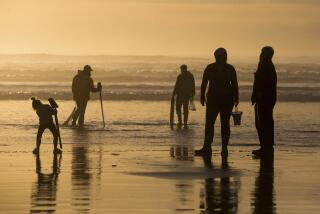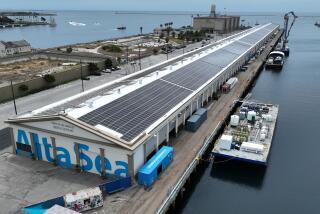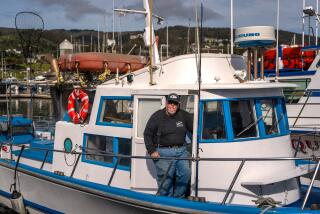Mussels Do Swimmingly, but Harvest Won’t Include Profit
When Dominic Gregorio decided to start the first shellfish farm off Orange County a little more than a year ago, state health officials said it probably wouldn’t work.
Water pollution in the area was too unpredictable to grow edible shellfish, they said. But the marine biologist was convinced that the area was ripe for cultivation and the waters were clean.
Now, a year later, Gregorio’s mussels are flourishing. But even with a healthy crop, he said, there may not be a profit in commercial mussel production.
At a wholesale price of $1 a pound, mussels may not be worthwhile to farm. “We’ll have to evaluate it after the harvest,” Gregorio said. He will harvest this first crop, which he estimates weighs a ton, within the next two weeks.
Last year, the 34-year-old researcher received a permit from the state Fish and Game Department to plant an experimental mussel farm about 500 feet off the Seal Beach jetty. Although state health officials warned that chemicals from surrounding industries might contaminate the fish, Gregorio contended that the washing action of the ocean around the jetty was strong enough to keep both the water and his shellfish clean.
Gregorio set up his farm by hanging about 30 ropes from a 300-foot-long horizontal rope near the surface of the water, and he planted his seedlings. The mussels have grown faster and cleaner than even he predicted, he said.
“It’s really a good place to grow mussels; the water’s so green, you can’t see a thing,” he said of the area’s abundant plankton, the food source for his shellfish.
After only nine months, the lines were filled with 50-millimeter mussels, about the size served at restaurants. They were unusually free of barnacles and other ocean parasites, Gregorio said.
Douglas Price of the state Department of Health Services agreed. “It doesn’t look like it’s the problem we thought it would be,” he said. The department tests all shellfish produced in California and has paid close attention to Gregorio’s project.
The tests showed that Gregorio’s mussels were not contaminated by metals or chemical pollutants--and even the level of coliform, a bacteria commonly found along heavily populated coastlines, was lower than expected, Price said.
Although Gregorio said mussel farming amounts to “sitting and watching them grow,” he admits that he has been lucky.
Shortly after he planted the seedlings last year, ocean currents carried an unpredictable mussel spawn through his farm. The baby mussels attached themselves to the ropes, almost doubling the size of his crop, he said.
And later in the year, the young mussels narrowly escaped annihilation from an nearby oil spill, he added.
The farm’s Seal Beach location “is a very complicated area,” Price said. It sits near the mouth of the San Gabriel River, where rainstorms dump debris from overflowing sewers and drainage systems.
Freighter lanes to Long Beach Harbor are only miles away, and the area is surrounded by marinas. All are potential sources of pollution, he said.
Gregorio’s sea-farming permit required him to move the fish to cleaner waters 30 days before a harvest to allow time for the filter-feeding fish to purge any coliform bacteria from their systems.
Last November, he moved the mussel-laden ropes to the pristine waters off Catalina Island, where he will harvest them.
Gregorio, who lives with his wife and two children in San Pedro, said there will be no profit from this first harvest, since the project already has cost him about $4,000 in equipment and testing.
But he takes that in stride. “You can’t plan to get rich quickly with any type of farming,” Gregorio said.
Meanwhile, Gregorio has about 30,000 abalone growing in tanks at the USC Marine Research Center on Terminal Island. Abalone grow only an inch a year, but they command a hefty wholesale price of $32 per pound.
Now that, he said, “is definitely commercially viable.”
More to Read
Sign up for Essential California
The most important California stories and recommendations in your inbox every morning.
You may occasionally receive promotional content from the Los Angeles Times.










